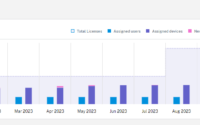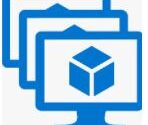Deploy and deliver the Liquidware Flexapp applications in Citrix DaaS
FlexApp is a dynamic application-layering technology that simplifies the deployment and management of applications within virtualized environments, such as Citrix DaaS (Desktop as a Service). This blog will dive deep into what FlexApp packages are, how they are deployed, and their significance in modern IT environments.

What is FlexApp?
FlexApp is a solution designed by Liquidware to enhance the flexibility and manageability of application delivery. It decouples applications from the underlying operating system, allowing them to be dynamically attached to user sessions or virtual machines (VMs) without the need for traditional installation methods. This decoupling enables seamless application delivery across different environments, reducing compatibility issues and streamlining management tasks.
How FlexApp Works
At its core, FlexApp operates by capturing applications into portable, self-contained packages. These packages are not installed in the traditional sense but are instead layered onto the user’s session or VM at runtime. This approach has several key benefits:
1. Simplified Management: By packaging applications separately from the OS, IT administrators can manage, update, and deploy applications independently, significantly reducing the complexity of managing large numbers of applications.
2. Improved Performance: Since FlexApp packages are delivered on-demand, they do not bloat the base image or require heavy system resources, resulting in faster load times and a more responsive user experience.
3. Enhanced Compatibility: FlexApp’s layering technology ensures that applications are compatible across various Windows environments, as the applications do not interfere with each other or with the base OS.
Deploying FlexApp Applications in Citrix DaaS
Deploying FlexApp packages within Citrix DaaS involves a few critical steps:
1. Creating the FlexApp Package: The first step is to capture the application into a FlexApp package. This involves using the FlexApp Packaging Console, where IT administrators can install and configure the application within a clean OS environment. The console captures all the necessary files, registry settings, and dependencies, packaging them into a portable format.
2. Storing the Package: Once the application is captured, the package is stored in a central repository. This repository can be a network share, a cloud storage solution, or any location accessible by the Citrix infrastructure.
3. Assigning the Package: After storage, the FlexApp package can be assigned to users or groups through Citrix Studio or the FlexApp Management Console. Assignment can be based on various criteria, such as user roles, departments, or specific needs.
4. Delivering the Application: When a user logs into their Citrix session or VM, the assigned FlexApp packages are dynamically attached to their session. This process is seamless and transparent to the end-user, who can immediately start using the application as if it were natively installed on the OS.
5. Managing and Updating: FlexApp makes it easy to manage and update applications. Updates can be applied directly to the package without requiring reinstallation or user downtime. The updated package is then delivered to users the next time they log in, ensuring everyone is using the latest version.
Benefits of Using FlexApp in Citrix DaaS
1. Reduced Image Management: Traditional application deployment often involves creating and maintaining multiple OS images to accommodate different application sets. With FlexApp, applications are managed independently, significantly reducing the number of images that need to be maintained.
2. Faster Deployment: Applications can be deployed almost instantly, as there is no need to install them on each VM or session. This is particularly beneficial in environments where new applications need to be rolled out frequently or where users have varied application requirements.
3. Improved User Experience: Because FlexApp packages are delivered on-demand, users experience faster logon times and can start using their applications without delay. Additionally, the reduced system resource usage contributes to a smoother, more responsive environment.
4. Scalability: FlexApp’s architecture is inherently scalable, making it well-suited for large enterprises or service providers managing thousands of users. The centralized management and dynamic delivery model ensure that scaling up does not introduce complexity or performance bottlenecks.
5. Flexibility and Portability: Since FlexApp packages are not tied to a specific OS or hardware, they can be easily moved between different environments, making disaster recovery, migrations, and cloud deployments simpler and less risky.
Use Cases for FlexApp
1. Application Isolation: FlexApp is ideal for scenarios where applications need to be isolated from the OS or other applications. This can include running multiple versions of the same application, avoiding conflicts between applications, or ensuring that specific applications do not impact system performance.
2. Dynamic Workspaces: In environments where users have varying application needs, such as universities or large enterprises with diverse departments, FlexApp allows for the creation of dynamic workspaces where each user receives the exact set of applications they need without bloating the base image.
3. Temporary or Seasonal Workforces: For organizations that hire temporary or seasonal workers, FlexApp enables the quick provisioning of workspaces with the necessary applications without the overhead of managing and maintaining these environments long-term.
4. Disaster Recovery: In disaster recovery scenarios, FlexApp’s portability ensures that applications can be quickly redeployed in a new environment without the need for lengthy reinstallation processes, minimizing downtime.
Challenges and Considerations
While FlexApp offers numerous benefits, there are also challenges and considerations to keep in mind:
1. Initial Setup Complexity: Setting up FlexApp requires careful planning and configuration, particularly in large, complex environments. IT administrators need to ensure that the packaging process is thorough and that all dependencies are captured correctly.
2. License Management: Managing licenses for FlexApp-packaged applications can be more complex, especially when applications are dynamically delivered to different users or environments.
3. User Training: End-users may require training to understand how FlexApp-delivered applications differ from traditionally installed applications, particularly in terms of how updates are handled or how to troubleshoot issues.
4. Testing: Thorough testing is essential to ensure that applications behave as expected when delivered via FlexApp. This includes testing for performance, compatibility, and user experience.
Conclusion
FlexApp packages represent a significant advancement in the way applications are delivered and managed within virtualized environments like Citrix DaaS. By decoupling applications from the underlying OS, FlexApp simplifies management, reduces costs, and enhances the user experience. While there are challenges to consider, the benefits of dynamic application delivery and the flexibility it offers make FlexApp a compelling solution for modern IT environments. As organizations continue to evolve and adapt to changing technology landscapes, solutions like FlexApp will play a crucial role in enabling agile, efficient, and scalable IT operations.


